1lumen selects and reviews products personally. We may earn affiliate commissions through our links, which help support our testing.
Lumintop FWAA review
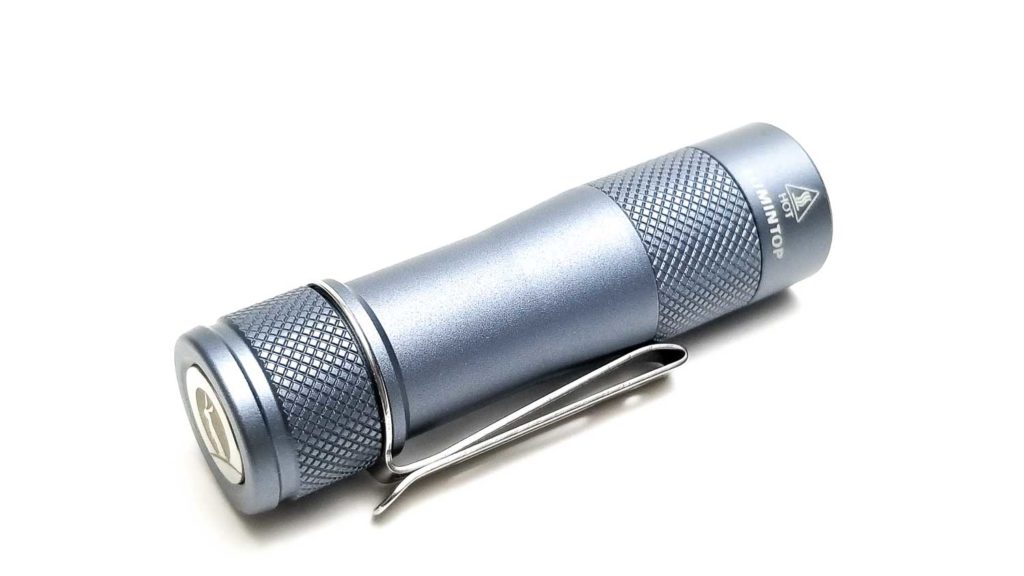
Lumintop FWAA specifications
| Brand/model | Lumintop FWAA |
|---|---|
| Category | Best EDC flashlights |
| LED | Luminus SST20 4000K 95 CRI |
| Max. output | 1,400 lm |
| Max. beam intensity | 2250 cd |
| Battery configuration | 1*14500 |
| Material | Aluminum |
| Modes | Many (Anduril2 firmware) |
| Blinkies | Many (Anduril2 firmware) |
| Reflector | Triple TIR Optic |
| Waterproof | IPX8 |
| Review date | June 2021 |
Introduction:
Lumintop has become a household name in the flashlight community and therefore needs no introduction. They are most known for partnering with flashlight enthusiasts to develop and design new lights. This is a great thing, and these collaborations have brought some pretty fantastic lights to market. Case in point: In 2018 Lumintop, with inspiration and expertise from members of the Budget Light Forum (BLF), brought us the ultra long range thrower flashlight dubbed the Gigathrower (which to date has no less than nine variations), followed in 2019 by the FW3A, which was the product of a collaboration with BLF and the German counterpart TLF. The FW3A was an affordable18650 powered triple emitter 2800 lumen EDC light running ToyKeeper’s incredible Anduril UI.
Naturally, it was an immediate hit, and two years later, there are more variations of this light than I can count on two hands. It was only a matter of time before Lumintop brought us a new FW series light, so today I’ll be taking a look at the latest member of the FW family, the FWAA. A big thanks to Nealsgadgets for sending this for review! Like the original this is a triple emitter light with an optic, but it’s not 18650-powered (the ‘AA’ in the name is a clue), so let’s see what Lumintop has whipped up.
Package quality.
I consider Lumintop to be a budget brand in terms of price and the packaging is certainly commensurate. The FWAA came in a small plain (but still nice) white box (a little roughed up from the post) with the brand name and a marketing blurb on the front. I like the box and the sizing is appropriate. On the back, you get some QR codes, company information, and a sticker with the emitter model and CCT. The box top lifts off to reveal the manual and a card showing how to insert the battery. The FWAA was sitting in microcell foam cut to shape with the cigar grip ring wedged between the box and foam. The lanyard was sitting in its own slot with the rest of the accessories riding in a plastic baggie. Here’s what’s inside:
- Lumintop FWAA flashlight
- 2-way pocket clip (attached to the light)
- 2 spare o-rings
- Battery installation instruction card
- User manual in English and Chinese
- Tactical cigar grip ring
- Lanyard
A battery is not included (you can order the FWAA from Nealsgadgets with one), but otherwise you get everything to get up and running. The lanyard is the cheap non-adjustable kind, but the manual is very comprehensive and mainly focuses on the UI (you’ll see why later). Overall a pretty complete kit.
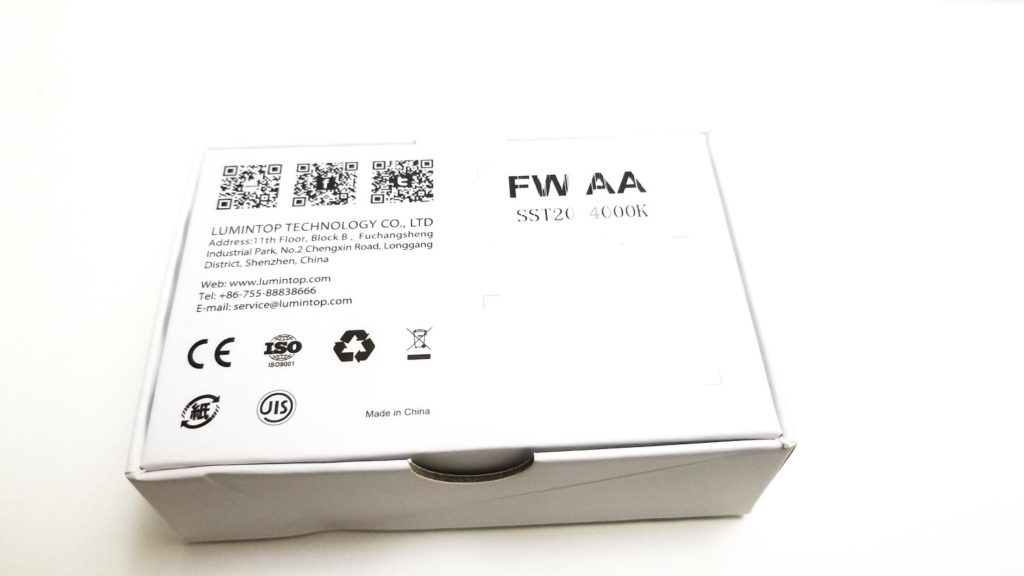
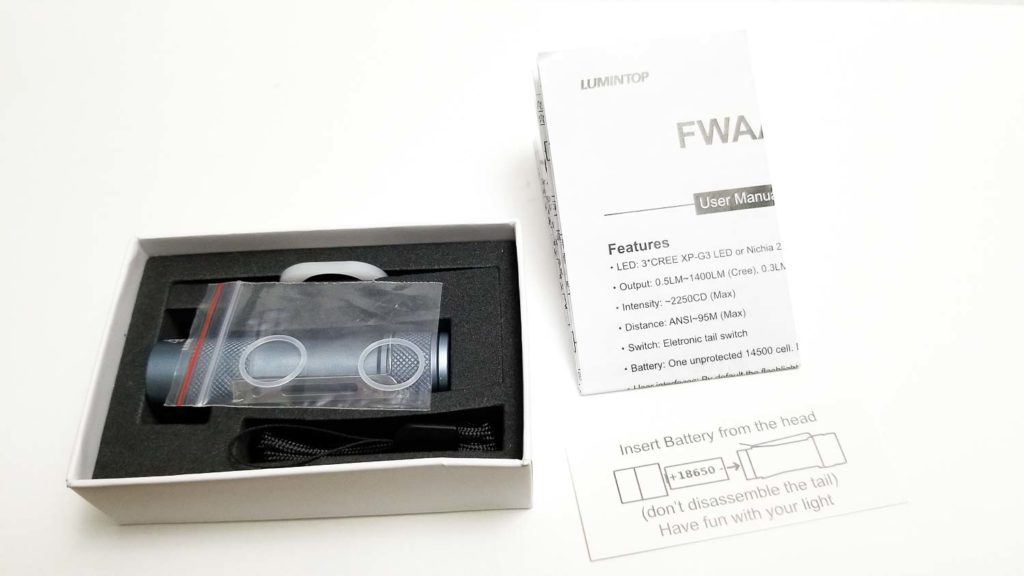
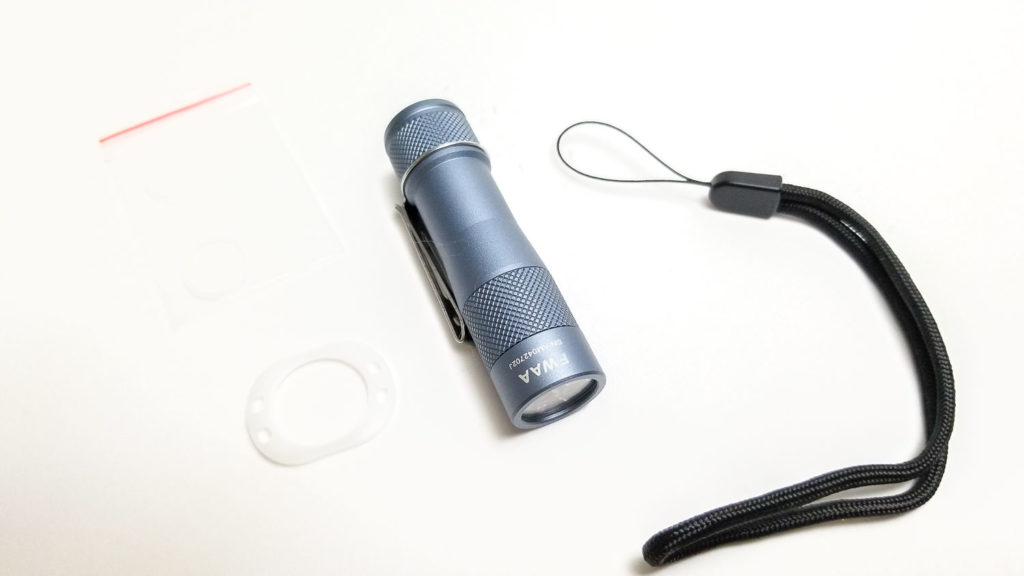
Flashlight in use
Okay, so let’s get the cat out of the bag. The FWAA is an FW3A shrunk down to accept a 14500 (AA-size) lithium ion battery. It’s like Wayne Szalinski got ahold of an FW3A and tested his shrink ray on it. Seriously, this is the best execution of size reduction in a flashlight I have ever seen. How Lumintop managed to cram a triple TIR optic and MCPCB in this small of a package is remarkable.
Dimensionally, it’s a small flashlight, and at under 3 inches is smaller than most of my other AA/14500 size lights. Despite the abbreviated size, this is a smartly designed light. I didn’t have any trouble handling it, and I’d say it handles a lot like my Skilhunt E2A. It had the right amount of ‘heft’ and didn’t feel cheap. There’s no knurling on the battery tube, but honestly, I don’t feel like it’s needed due to the grippy finish. I like how Lumintop included a tactical grip ring for easier handling, but I don’t think I will use it much. It does have two holes opposite each other for mounting the lanyard, so along with the pocket clip, you have several ways of attaching the lanyard.
The FWAA retains the all-too-familiar FW-series rear e-switch which sits flush with the tailcap, so you can tail stand it. It’s also appropriately large for human-sized hands, so kudos to Lumintop for putting a switch-button that’s not sized for Hobbits or wood elves. Also, I must add that this is the most elegant button I have ever seen. The familiar Lumintop bunny logo is laser engraved on the aluminum button and looks really slick, plus adds texture. This was not present on the pre-production lights and it’s a really nice detail item.
I didn’t have any trouble locating and manipulating it with my finger or thumb, and while the switch works fine, the click action is a little mushy, and almost too bouncy and touchy. This made it easy to accidentally double click or click and hold when switching on, which puts the light straight to turbo which was unbelievably annoying. I would have preferred a more positive and solid click action. There’s also a noticeable delay when switching the light off, maybe 0.5 seconds from releasing the button to shut off which I wasn’t expecting. Alas, at least the switch won’t spill its guts out when taking off the tailcap (early versions of the FW3A had this issue).
For pocket carry, the included stainless pocket clip is a captive or collar-type two-way design so you can switch between bezel up or down carry without removing the clip. This enables you to use it as a headlamp when clipped to a baseball cap bill or clip it to your watch band or sleeve for some hands-free action. The clip has good clamping tension, but the downside of a collar clip is you have to remove the tailcap to take it off. It’s worth noting that you could mount the clip between the bezel and body if you wanted.
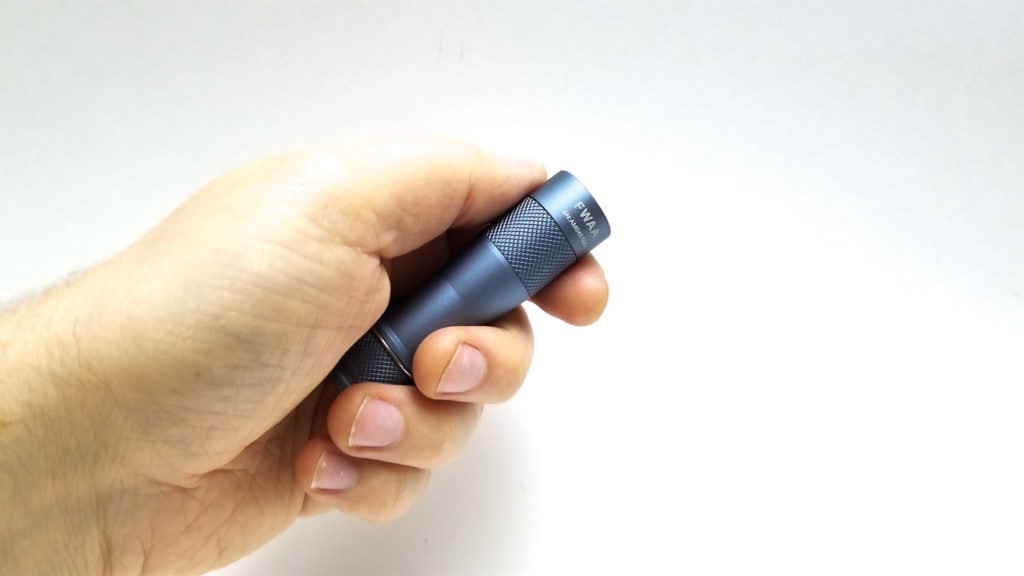
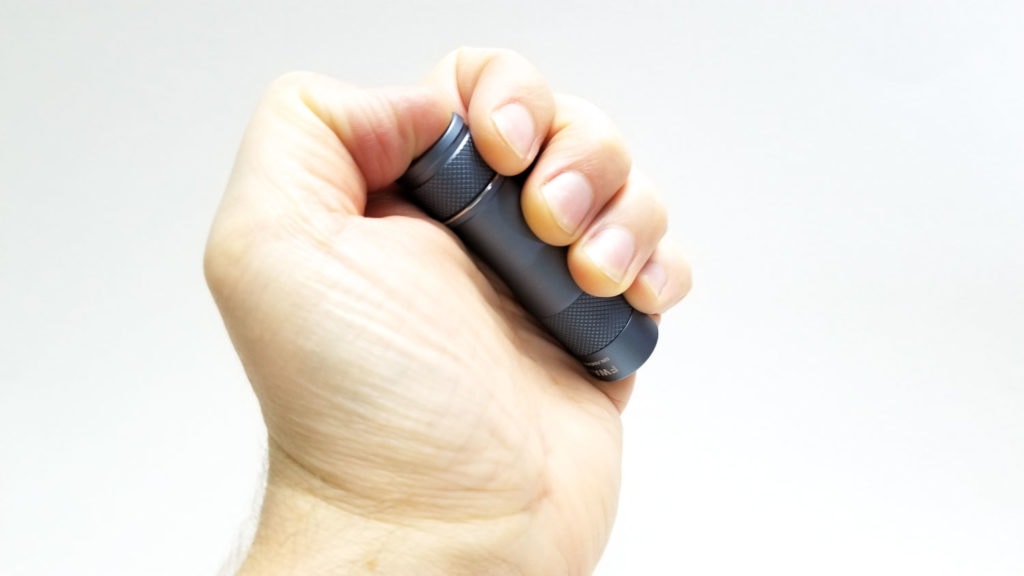
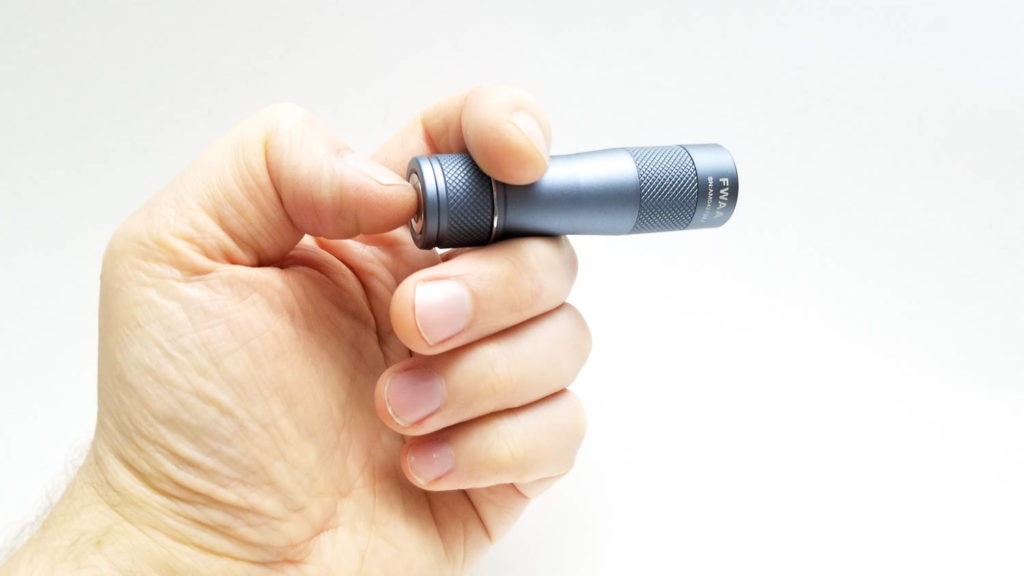
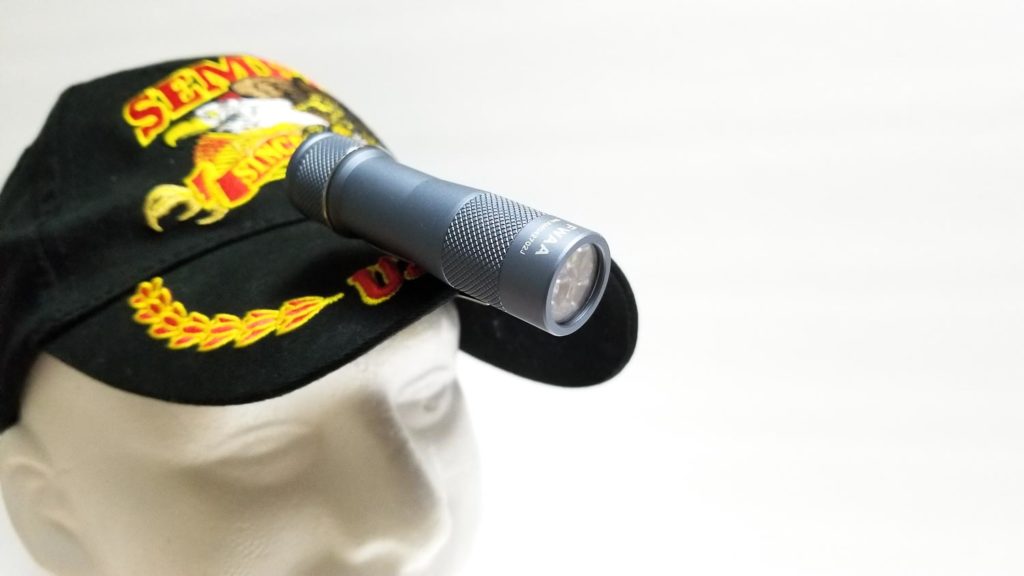
Build Quality, and Warranty
Okay, if I were adjudicating the Lumintop FWAA entirely on looks, finish, and fit, then I’d end the review right here and just give it 5 stars. Seriously, I was pretty chuffed to bits when I first handled the FWAA. It doesn’t just look premium but feels just as nice. I think the quality is definitely indicative of something much more expensive.
The matte slate gray anodizing is absolutely gorgeous, with perfect coverage, no thin or bare areas, and no dings or chips. Dare I say it rivals my favorite Acebeam finishes? The machining is equally top-notch with no machine marks, burrs, or sharp edges anywhere. Every corner and edge is chamfered and beveled to perfection, which is perfect for EDC There’s diamond pattern knurling on the tailcap and head, and it’s about as good as knurling gets, very precisely cut and finished. For those who can’t keep their prying fingers out of their lights, the FWAA retains most of the FW3A’s moddability since nothing is glued or Loctited together. It breaks down into 5 parts: tailcap, head, bezel, lens, and TIR optic. I must say that the MCBCP is properly thick, at least 2.5 or 3 mm of copper.
The front and rear threads are precisely-cut rectangular affairs and are a little fine, so be careful when removing or replacing the tailcap or head to prevent cross threading. The threads weren’t the smoothest I’ve felt, and either weren’t lubed or very lightly lubed, so I recommend some silicone lube or SuperLube for added smoothness. Every joint or mating surface is sealed with a single o-ring and Lumintop gives the FWAA an IPX8 rating, which isn’t a full ingress protection rating (‘X’ indicates the criteria is not rated, in this case solid particle ingress), but it should be good for immersion up to 1 meter and dustproof.
Lumintop gives you a very generous warranty: 30 day free repair/replacement for manufacturing defects, 5 year limited warranty for manufacturing or quality defects for flashlights, 2 years for built-in batteries, 1 year for batteries, and lifetime limited warranty that covers repairs, but not parts and labor.
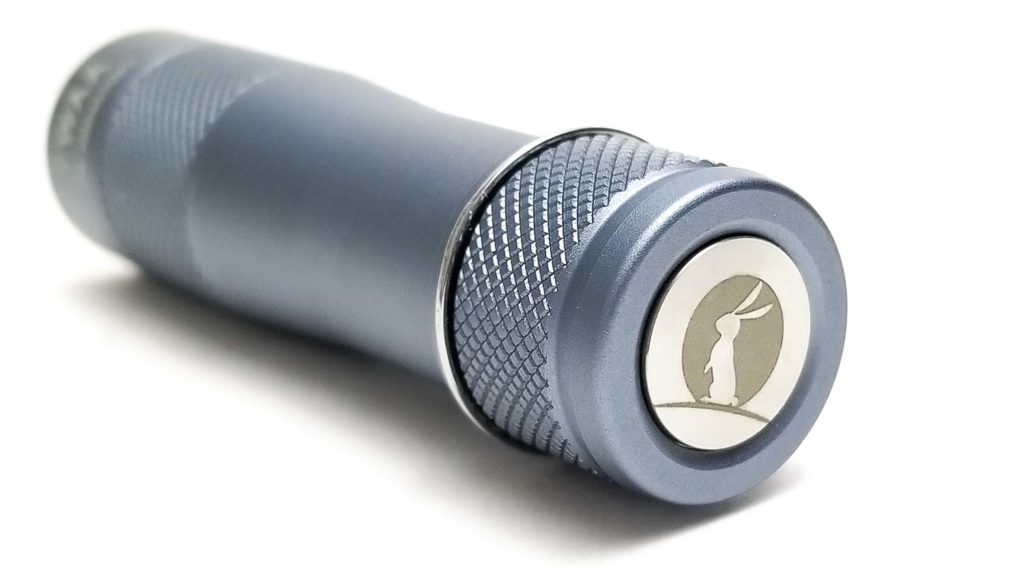
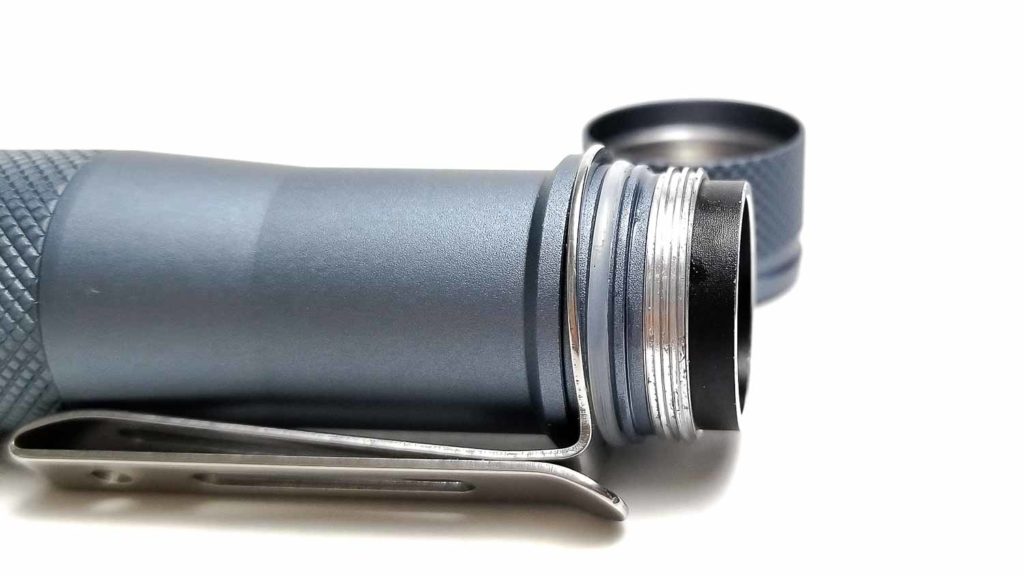
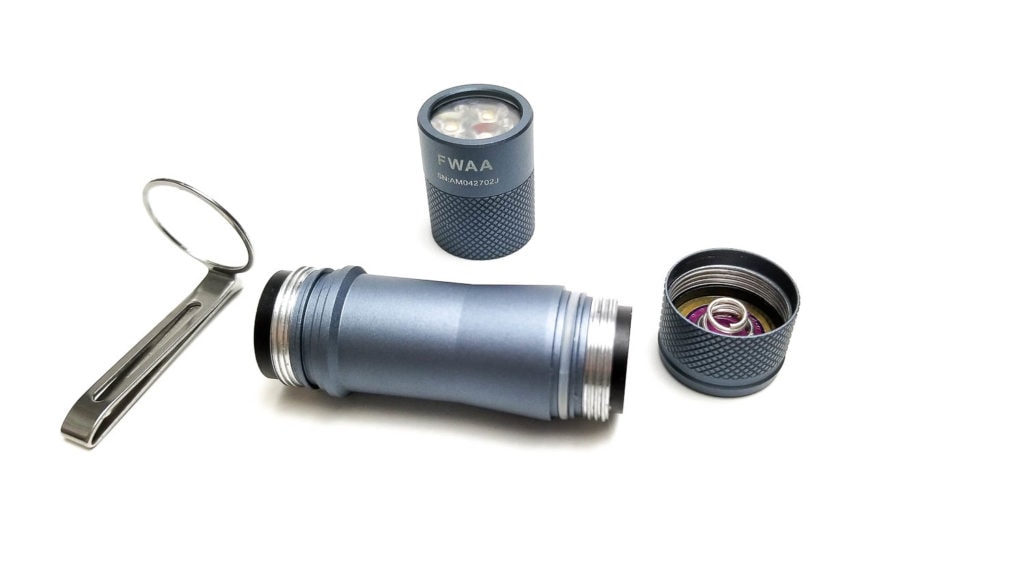
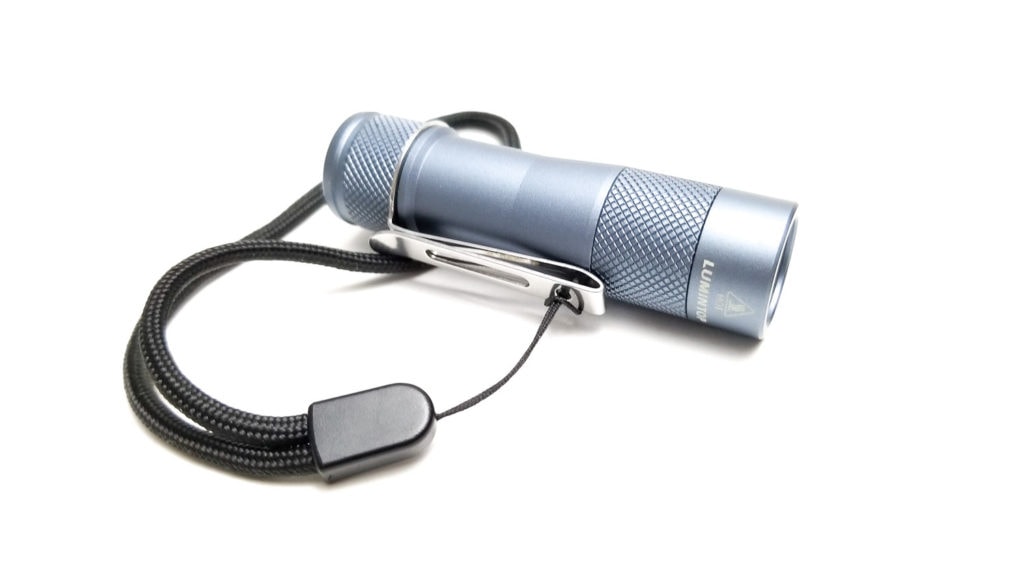
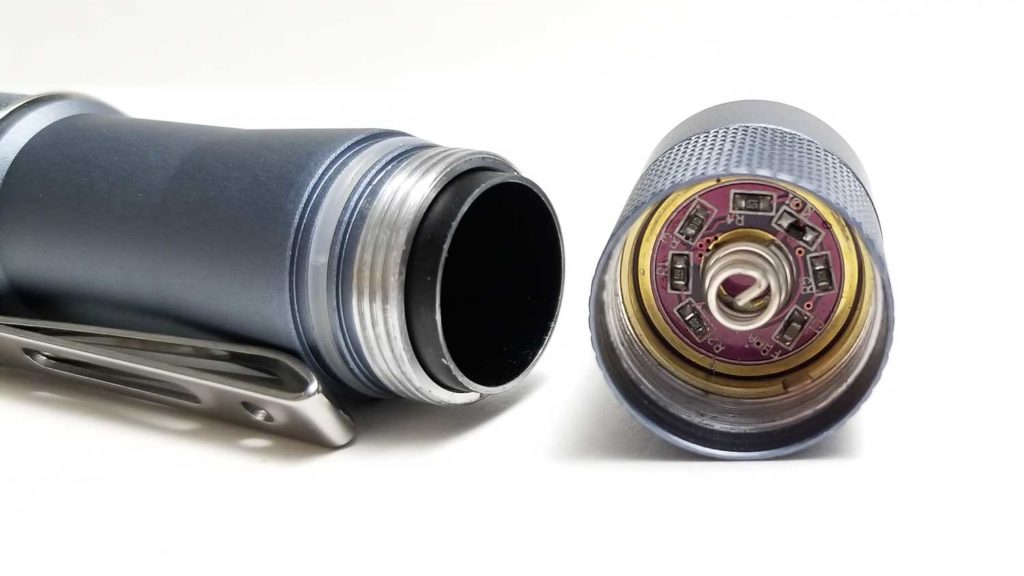
LED, Lens, Bezel, and Reflector
In keeping with the FW theme, the Lumintop FWAA has a triple LED arrangement, and you can choose from a nice selection of LEDs including 3 flavors of Nichia 219C in 3000, 4000, or 5000K (90 and 70 CRI, respectively), Cree XP-G3 in 6500K, and 4000K Luminus SST20 in 95 CRI. My sample came with the latter. This is a good selection, but if you want different emitters and have the skill, you could reflow any 3535 footprint LED onto the DTP MCPCB, provided it fits under the optic.
The optic is a Carclo-type TIR, but this one is proprietary and seems custom made for Lumintop. It’s about 17 mm wide by 5.5 mm tall. It sits under an AR coated glass lens which is a nice touch. The bezel is not crenulated, which is fine, and the lens is slightly recessed about 1 mm below the edge of the bezel for added protection.
The optic is also frosted slightly for more flood, and no surprise, the FWAA is mainly a flooder. I found the beam to be very useful for EDC duties with a diffuse hotspot out to about 5 meters. Beyond that it becomes a wall of warm high CRI light. It’s not throwy by any means, but there is enough to be useful out to maybe 50 meters (albeit on higher settings), which is pretty good for a small TIR. If you want more throw than the SST20 (which are the throwiest LED option), you’d need to swap the emitters or try to find a more throwy optic, which may be nearly impossible unless they become optional add-ons (Hint, hint, Lumintop).
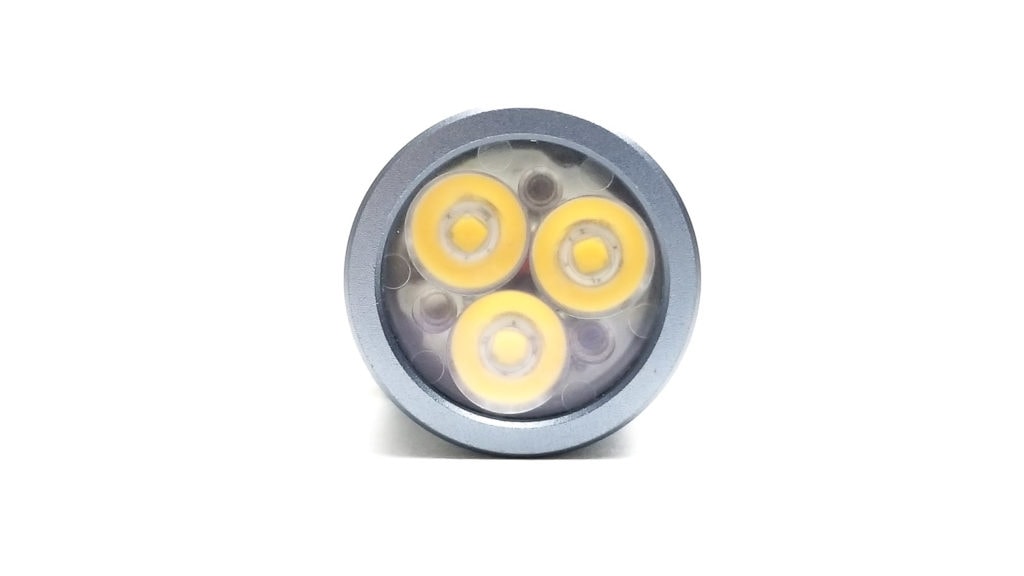
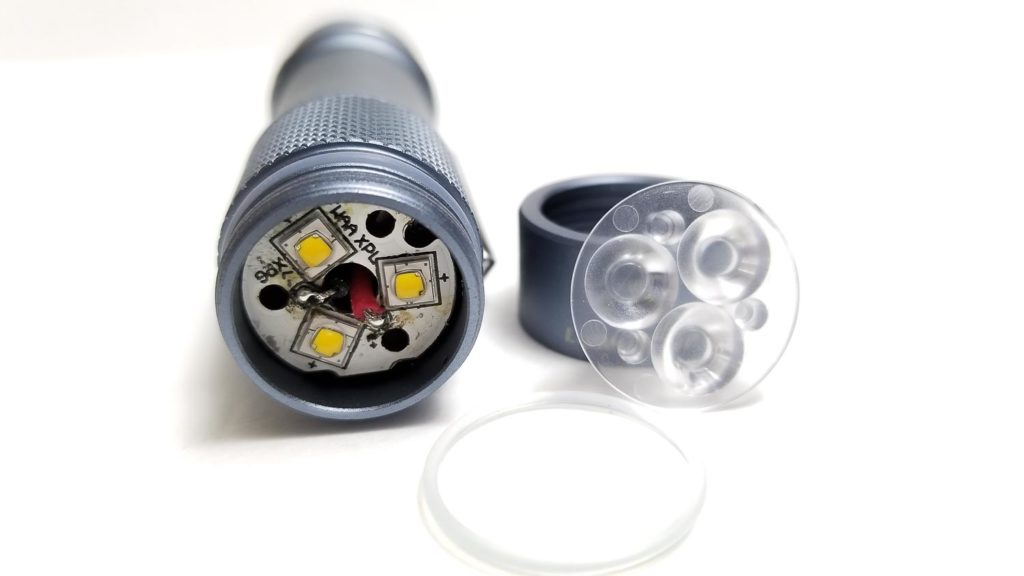
Dimensions and size comparison
- Head diameter: 2.0 cm / 0.78 inches
- Overall length: 7 cm / 2.75 inches
Weight:
- Without battery: 33.9 grams / 1.19 oz.
- With Epoch 1000 mAh 14500 cell: 56 grams / 1.97 oz.
In comparison, the FW3A is 3.64 inches long and 1 inches wide, and 53 grams unloaded, so the FWAA is quite a bit smaller and lighter.
AA Flashlight size comparison
Compared to some small AA-size flashlights. Left to right: Lumintop FWAA, Skilhunt E2A, Sofirn SP10S, Thorfire TG06.
Compared to a Thorfire C8 and 14500 battery.
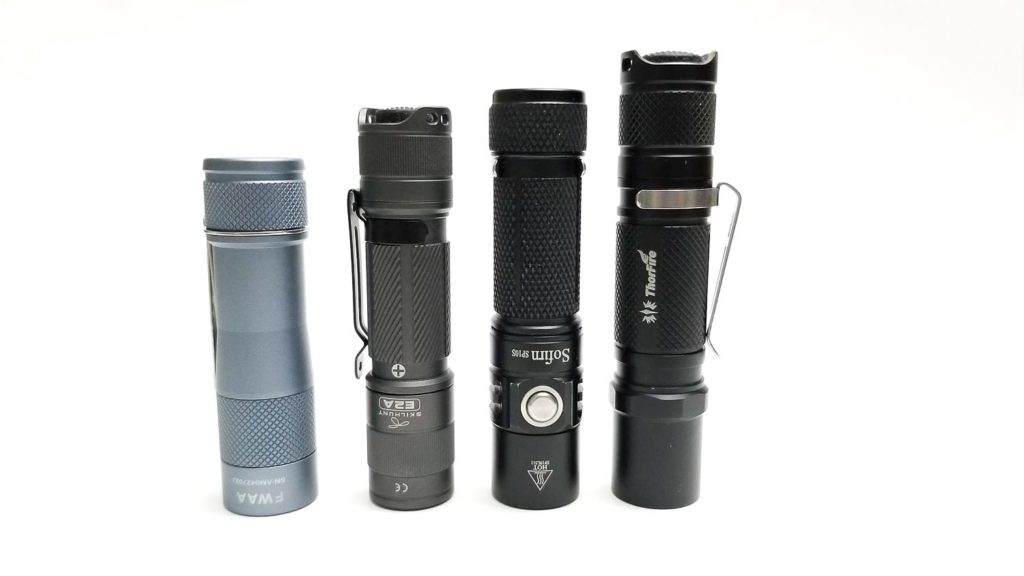
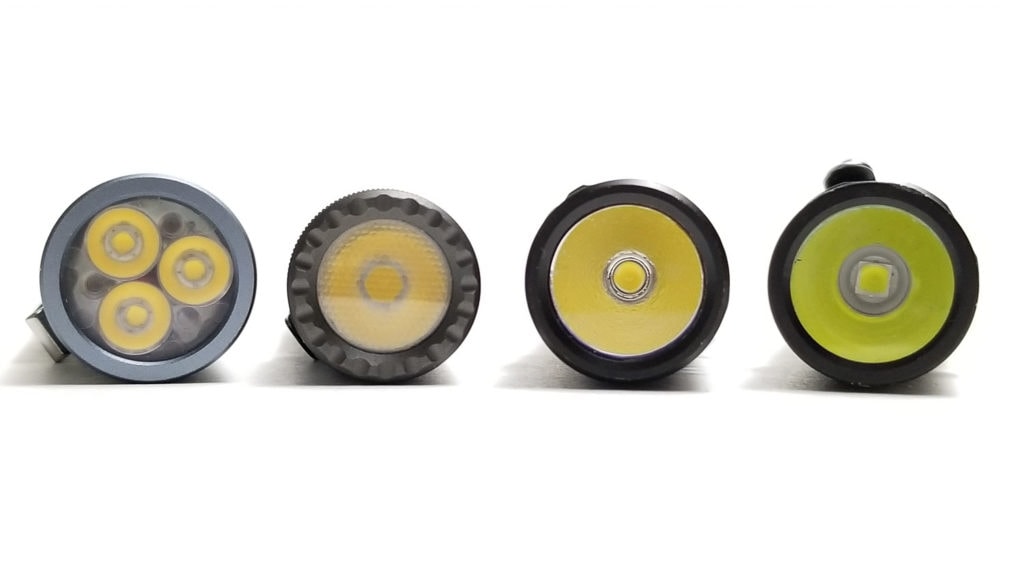
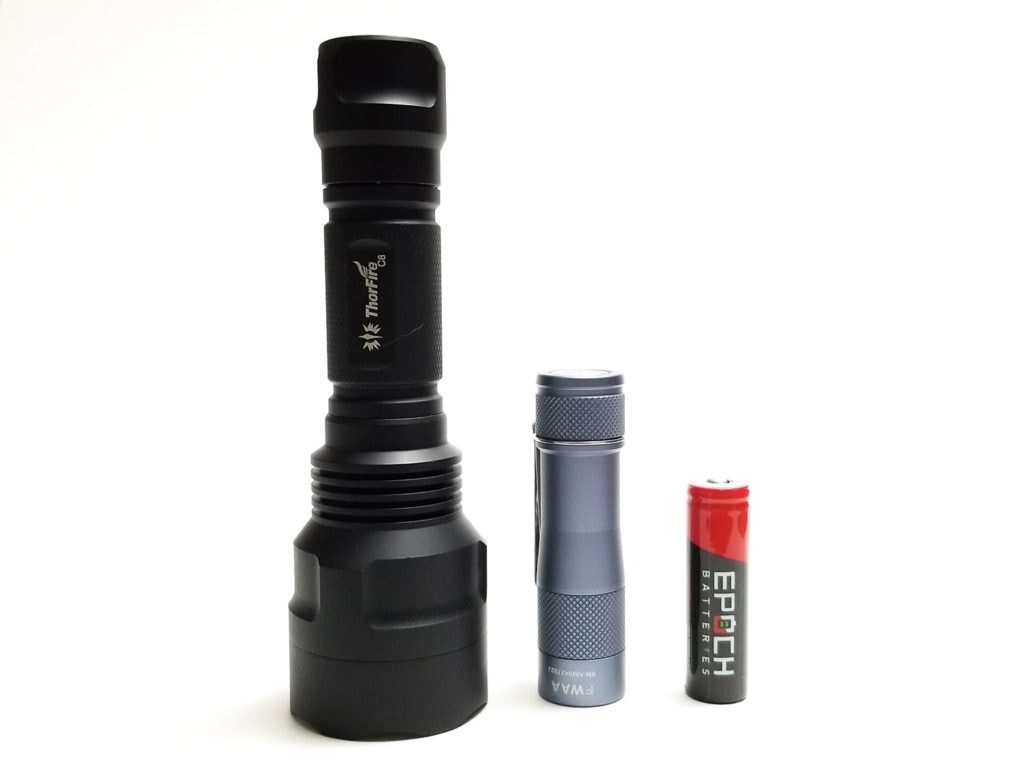
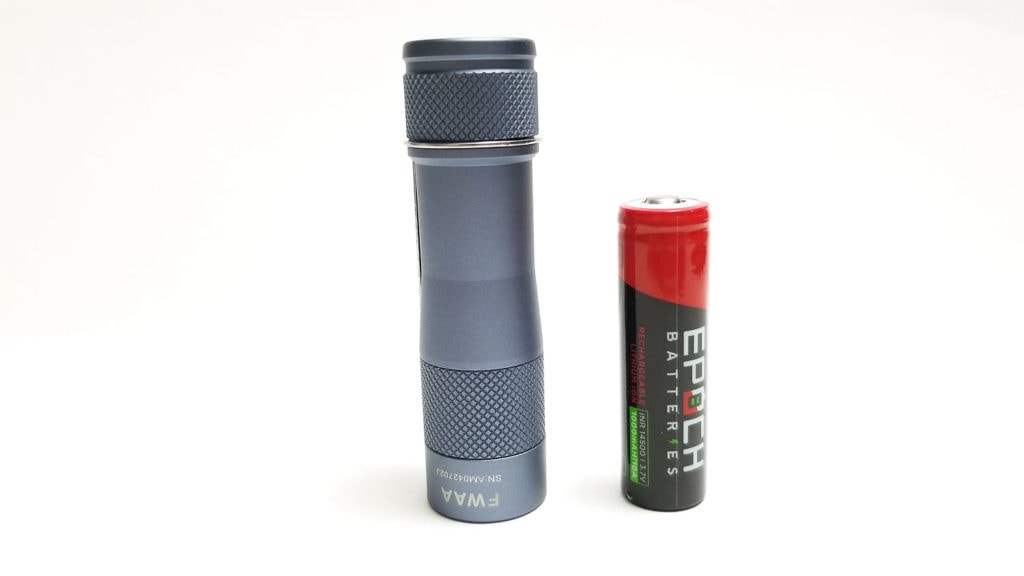
Driver & User Interface:
The Lumintop FWAA uses a FET+1 driver so performance is largely dependent on the battery you’re using. A high drain battery is recommended for max performance.
Naturally, the FWAA is sporting Anduril. However, you won’t find the regular flavor of Anduril on here because it’s been eschewed in favor of Anduril2.
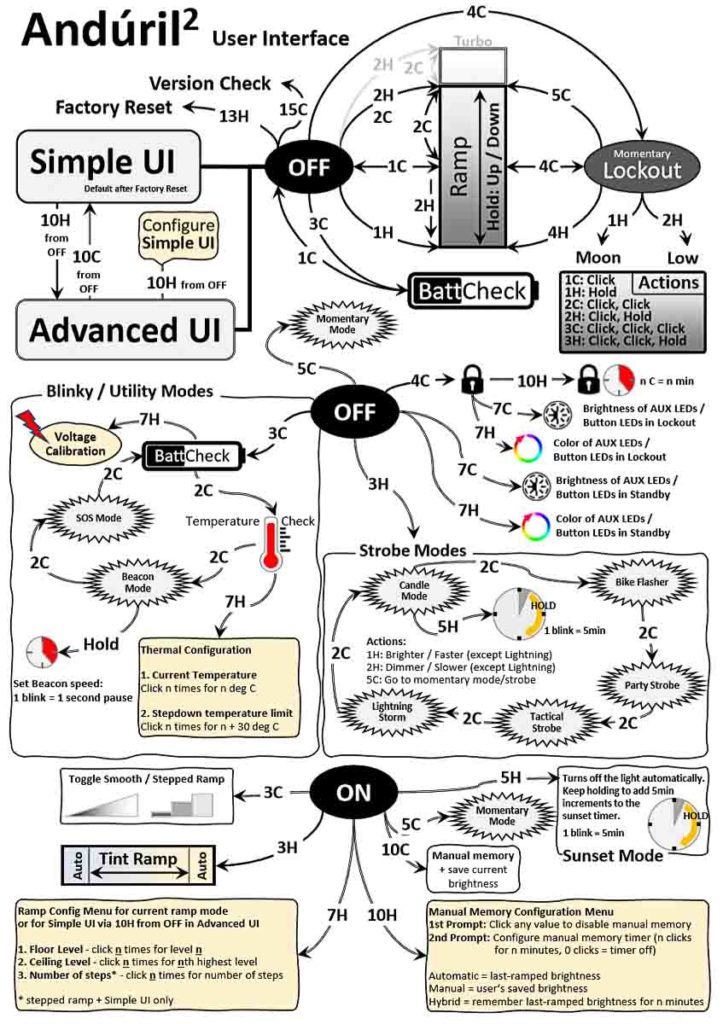
Anduril2 has two UI’s available: Simple and Advanced. The light came with the Simple UI enabled, and I think it’s kind of a misnomer because it’s still a little complicated for a first-time user. However, those familiar with the original will pick it up pretty quickly. Simple UI is missing some of the familiar features present in the original, namely the special blinky modes, temp check, and thermal configuration (those are present in the Advanced UI), and there’s no “muggle” mode either. You still get access to smooth ramping (stepped is, you guessed it, only available in Advanced UI), lockout, momentary high, battery check, and some useful lock/unlock modes.
The Advanced UI is appropriately named because it’s, well, advanced and there’s a plethora of options and configurations available. There’s probably way more features than the average user would ever dip into, but it’s nice to know you can tweak things like the voltage sensor calibration for batt check, AUX LED settings, and even configure the auto lock. I found this to be a pretty useful feature that enables the light to automatically turn off after a certain amount of time if the light is accidentally activated. Thanks ToyKeeper!
Modes: Simple and Advanced UI both have many standard and blinky modes available, but the main modes are stepped and smooth ramping, but stepped ramping is only available in Advanced UI, and smooth is enabled in both Simple and Advanced.
Switch to Advanced UI from Simple: 10 clicks, but hold on the 10th click
From OFF:
- Press and hold: Turns on in either smooth or stepped ramp (depending on which mode is enabled)
- Single click: Turn on in last mode (step or ramp state-again depends on which mode)
- Double click: Ramp ceiling/turbo
- Triple click: Battery check (in Simple and Advanced UI)
- Triple click and hold: Special strobe modes-remembers last used (in Advanced UI)
- Quad click: Lockout mode. In lockout mode you have different options available:
- 1 click: momentary moon (bottom of ramp)
- 2 clicks: momentary (higher floor)
- 4 clicks: turns on in ramp mode
- 4 clicks with a hold: on in ramp mode, lowest/floor
- 5 clicks with a hold: on in ramp mode, highest/ceiling
- 10 clicks with a hold: configure the lock timeout threshold (in Advanced UI only). This is a new feature for Anduril2, it allows you to set a timeout to the lock, where the light will lock after a pre-set elapsed time.
From ON:
- Press and hold: Ramp up (depending on the mode)
- Single click: Turn off
- Double click: Ramp ceiling/turbo
- Double click and hold: Ramp down
- Triple click: Toggle between smooth and stepped ramping (in Advanced UI only)
- Quad click: Lockout mode (see above for the lockout options)
Mode memory:
- Yes, memorizes last on state setting either smooth or stepped ramping, but does not remember blinkies
Low voltage warning:
- Yes, when in operation, the light steps down brightness gradually until turning off when the cell is around 2.9 volts.
Strobe/blinkies
- Yes, many! The blinkies are accessible from off with 3H (click click click-hold) in ADVANCED UI only. You switch between strobe modes with 2 clicks:
- Candle mode
- Bike flasher
- Party strobe
- Tactical strobe
- Lightning storm
Lock-out mode:
- Yes. In Simple or Advanced UI, lockout is accessed by 4 clicks from on or off. 4 clicks to unlock. The lockout enables momentary operation in the moon mode, however, 2H (click click-hold) enables low mode. There are other lockout modes available (see the diagram).
Temp check and thermal calibration mode
- In the first version, you could do both the ambient temperature sensor calibration and thermal ceiling at the same time, but in Anduril2, it’s a little different. When in temp check, click 7 times and hold on the 7th to enter the thermal configuration. To configure the ambient temp, wait for the first flash and then set the ambient, but once you’ve done that, you need to go back to the temp check and click 7 times, hold on the 7th, this time, don’t let off the button. Wait for the 2nd blink, and then you can set the thermal ceiling.
PWM
- Yes. PWM is visible on all modes, but it’s a very fast PWM and not visible with the naked eye.
Additional info: Anduril2 is a very comprehensive UI and has a ton of configurability, but it’s not perfect. I wished they hadn’t moved some of the most useful functions to the Advanced UI. Also, my wife pointed out a novice user could potentially melt something or burn themselves even in Simple UI since the full output ramp is available. However, I digress because I think a novice could totally get the hang of the simple UI after some finagling. Here’s a question I kept asking myself, and I’m sure some of our readers might ask: How do you know you’re in Advanced UI? The easiest way is to see if you have access to stepped ramping because it’s not available in Simple UI.
The LVP works fine down to 2.9’ish volts with the light getting dimmer and dimmer before turning off as expected. Not surprisingly, the thermal calibration was off from room temperature (33 vs. 24 C), but here’s a tip to set the calibration and the thermal ceiling. You can set it to the pre-calibrated level (or if you manage to muck up the light with your tinkering) by doing a factory reset.
Anduril2 Factory Reset:
Loosen the tailcap, hold down the switch button while tightening the tailcap, and keep holding for 4 seconds or so. You will get some odd blinking and a full power burst to indicate the reset was successful.
Batteries & Charging
As the “AA” in the name suggests, the Lumintop FWAA uses 14500 lithium-ion batteries. Note that 1.5 volt batteries will not work and Lumintop recommends a 50.5 mm overall cell length limit. I didn’t have any protected cells so I couldn’t test that, but I did have some button top and flat top cells and they fit fine. Also, you will want to use high drain cells for maximum output, but could also use weaker cells for reduced output (maybe safer for novice users). The FWAA doesn’t have built-in charging, so you will need an appropriate lithium-ion charger.
Pro tip: the battery should be loaded from the head to prevent potential issues with a bad connection. If you do load the battery from the tailcap, you have to loosen the head slightly, then tighten the tailcap all the way, then tighten the head.
Performance
Lumintop advertises the FWAA at 1400 lumens depending on where you look but is reported to be able to put up some pretty outstanding output figures for a tiny light, so I’ll be interested to see how it does.
Amp measurement
The e-switch relies on the inner sleeve in the battery tube for the switch signal so the current path is a bit tough to get at. Getting a current measurement was really difficult, but I was able to get the parasitic drain, and it came in right at 0.20 mA.
Runtime graph
I conducted the runtime test using the 30-centimeter integrating sphere with the Digi-Sense 20250-00 data logging lux meter and tested stepped levels 4, 5, 6, and 7 (aka ramp ceiling/turbo). The temperature was calibrated to ambient 23 C and the thermal ceiling set to 60 C. I used a fully charged Epoch brand 1000 mAh 10 A 14500 cell. I suspect this is the same cell as the VapCell H10 and Shockli 10 amp 1000 mAh 14500 with a different wrapper. I measured the temperature with my Ames Instruments noncontact thermometer.


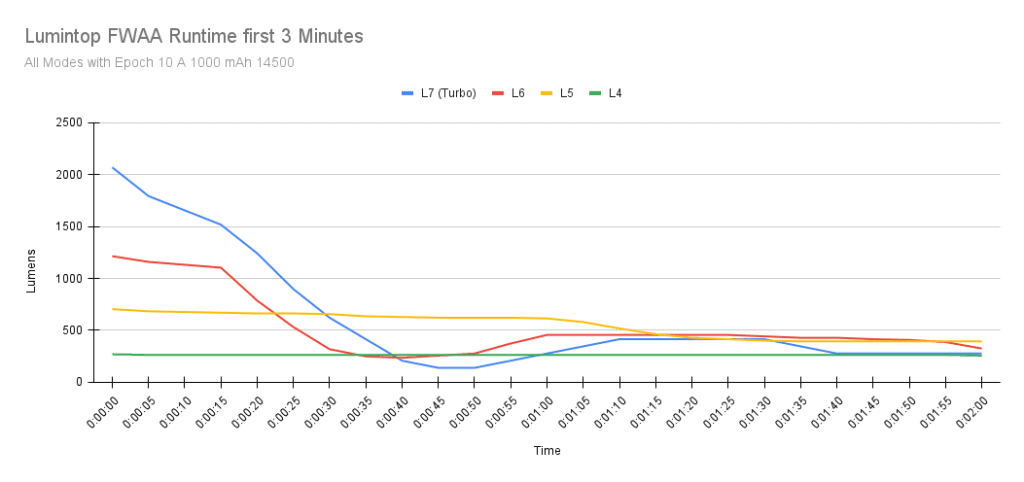
L7 (ramp ceiling/turbo) started at 2070 lumens, which is incredible as it is short-lived, lasting just 2 seconds before the aggressive step down ensued. At 10 seconds the output is 1656 lumens and just 20 seconds later, the output was 621 lumens. As you can expect, along with the high output comes heat, and it heats up fast: At 10 seconds the temperature was 47.4 C, and at 30 seconds the temperature was 53.3 C. The max temperature I saw was 61 C, so the thermal sensor is pretty accurate.
In typical Anduril fashion, the light stepped down proportionately to the temperature and throttled as the light cooled off and warmed up as we can see from the graphs. This continued until the 5 minute 53 second mark when the output settled to 138 lumens and stayed there until the 1 hour 7 minute mark when the output dropped to under 7 lumens. I ended the test a short time later since it would have continued to run for hours and hours at this level.
Level 5 and 6 behaved similarly to level 7, with fast stepdowns. Level 6 started at over 1200 lumens, but started ramping down immediately. By 20 seconds it was down to around 786 lumens and the temperature was 53 C. The output continued to throttle until the 58 minute mark when there were gradual step downs for the next 10 minutes until I ended the test at the 1 hour 9 minute mark after the output dropped very low and I ended the test.
There was similar behavior with level 5. The test started at a hair over 700 lumens, but held that output much better than the previous 2 steps, dropping below 400 lumens after 1 minute and 35 seconds. Strangely, the runtime was shorter than level 6, with the output dropping off to the very low level after just 1 hour 6 minutes when I ended the test. I saw the same output throttling as the temperature rose and fell, and the highest temperature I saw was 60.4 C at the 3 minute mark. That’s 140 F, and too hot for bare hands.
Level 4 was by far the most usable mode for output vs. sustainability. You still wouldn’t want to use it for prolonged periods because It still heated up pretty quickly, and by 70 seconds was pretty hot for bare hands. The output held pretty steady, starting at 269 lumens and gradually stepping to 200 lumens by the 14-minute mark. Not bad. I observed the same gradual step downs over the next hour until the output dropped below 7 lumens and I ended the test after 1 hour 17 minutes.
Takeaways? The FWAA behaves like any FET+1 light running Anduril. Since this is a tiny host with minimal heat sinking, the output and sustainability is somewhat dependent on the battery you use and how you set the thermal ceiling. The great thing about Anduril2 is that you can set the thermal ceiling to whatever you’re comfortable with. Despite my jonesing for more power, with the FWAA, I must digress because it’s advisable to keep the threshold conservative. This light isn’t meant for long runs at high output anyways (unless you like holding real hot objects in your hands). Lastly, the light is still usable after the runtime tests at reduced output (around 230 lumens at the top end) which is still plenty bright.
Lumen measurements (for each mode)
For the lumen tests, I used my home made 30 cm integrating sphere calibrated with a light of known output using the Digi-Sense 20250-00 data logging lux meter. Battery used was the same fully charged Epoch 14500 used with the runtime tests. Readings taken at 30 seconds. Since the stepdowns are so abrupt, I included turn on readings for levels 5 through 7. Even level 4 stepped down a bit.
| Step mode: | Measured Lumens | Advertised Lumens |
|---|---|---|
| 1 | 4.83 | ? |
| 2 | 29 | ? |
| 3 | 77 | ? |
| 4 | 269 | ? |
| 5 | 662 (717.6 at turn on) | ? |
| 6 | 331 (1269.6 at turn on) | ? |
| 7 Ceiling/turbo | 469 (2070 at turn on) | 1400 |
A few things about these numbers: First, Lumintop doesn’t give output figures for the SST20 configuration, so I listed their advertised figure. Second, the turbo figure at turn-on is simply astounding: over 2000 lumens from a light under 4 inches long and under 1 inch wide.
Throw numbers:
The FWAA is a flood-type light not designed for throw, and Lumintop makes no claims of radical throw figures. Measurements taken at 5 meters indoors using the Uni-t UT383S lux meter. Since the output drops so fast. I included the turn on figures in parentheses. Lumintop only listed one figure for throw, and I suspect it’s for the ramp ceiling, and not specific to any of the optional emitters.
| Step mode: | Measured Throw | Advertised Throw |
|---|---|---|
| 1 | N/A- too low | ? |
| 2 | N/A- too low | ? |
| 3 | 175 cd, 26.45 m | ? |
| 4 | 825 cd, 57.44 m | ? |
| 5 | 2125 cd, 92.19 m | ? |
| 6 | 1425 cd, 75.49 m | ? |
| 7 Ceiling/turbo | 2000 cd, 89.44 m (6825 cd, 165.22 m at turn on) | 2250 cd, 95 m |
This is surprisingly good performance from a small light. It throws far enough for most EDC tasks, so no complaints.
Beamshots
I tested the FWAA against the Skilhunt E2A with a single SST20 and Sofirn SP10S with Samsung LH351D 5000K 90 CRI. I used the same Epoch 14500 battery for all lights.
- The door at the end of the long hallway is about 15 meters away. All lights tested on the highest setting
- The wall at the end of the hall in the second photos is about 10 meters away and gives a better idea of the close-up beam pattern of the FWAA
- The wall with the map is about 5 meters away. Mode was ramp ceiling/turbo. It easily lights up the whole office!
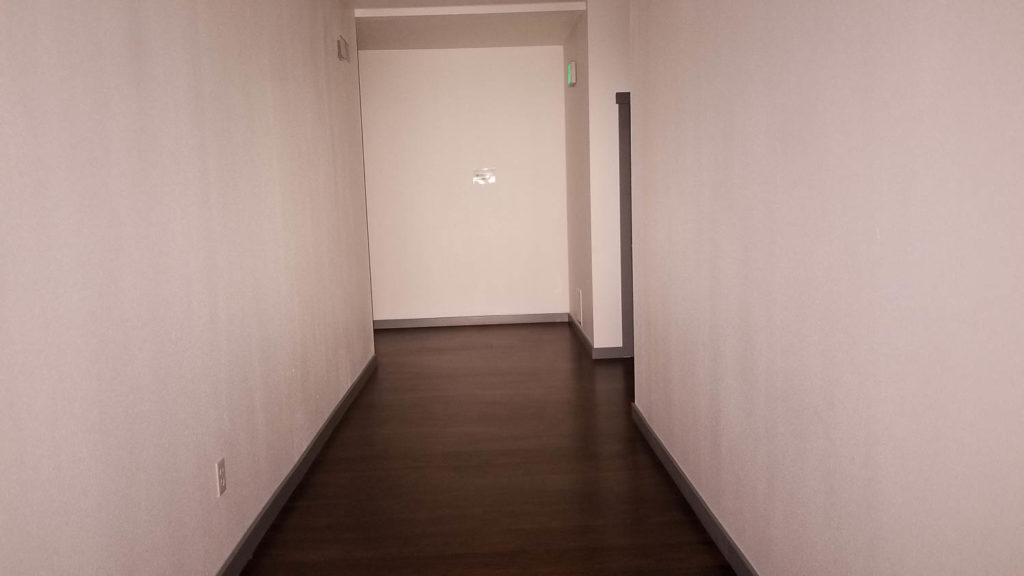
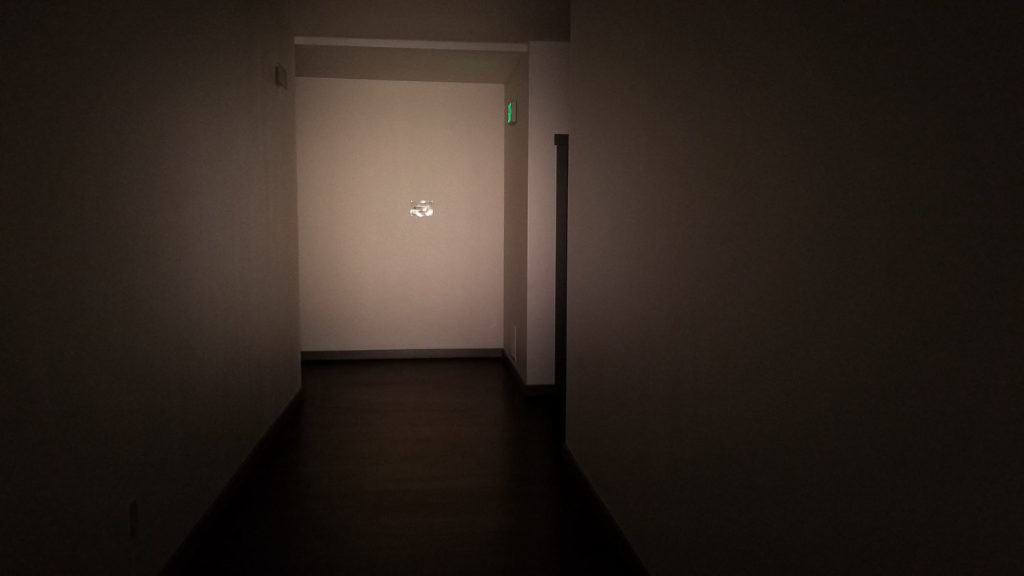
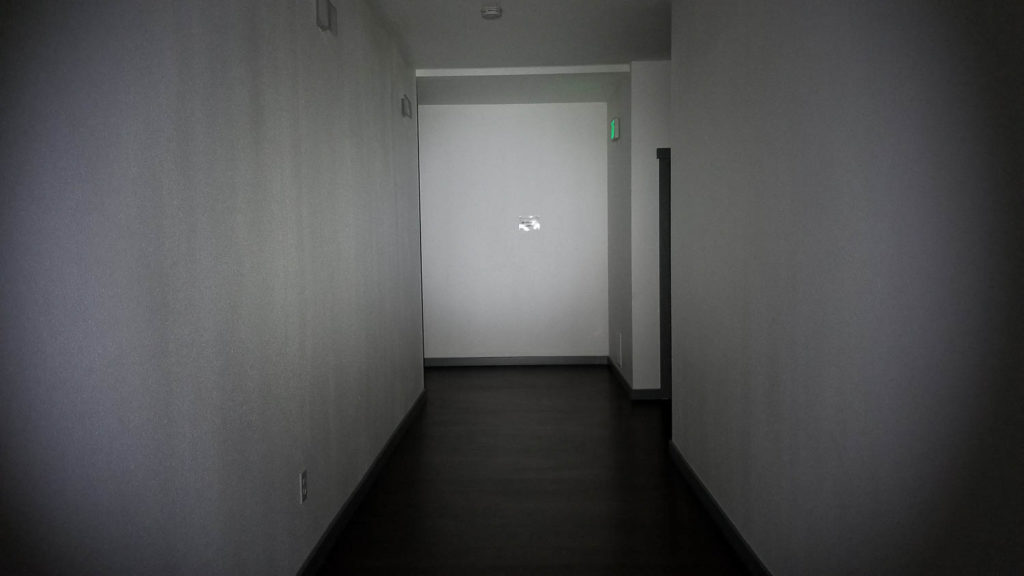
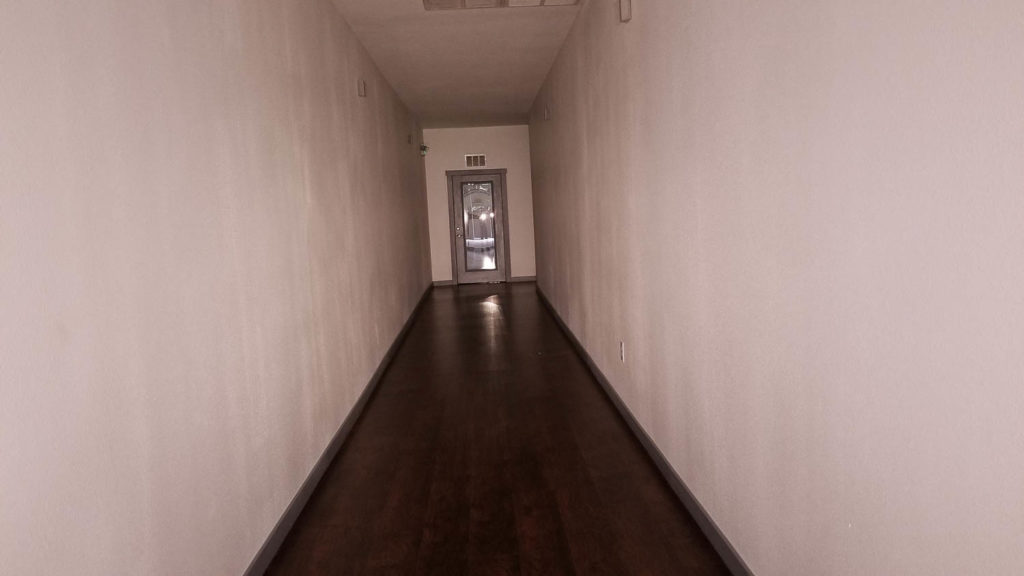
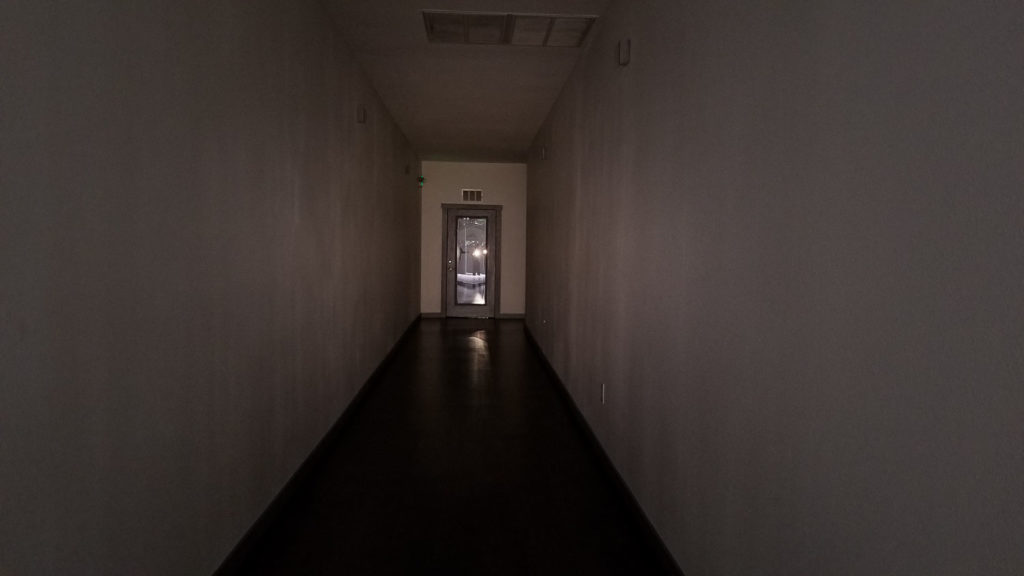
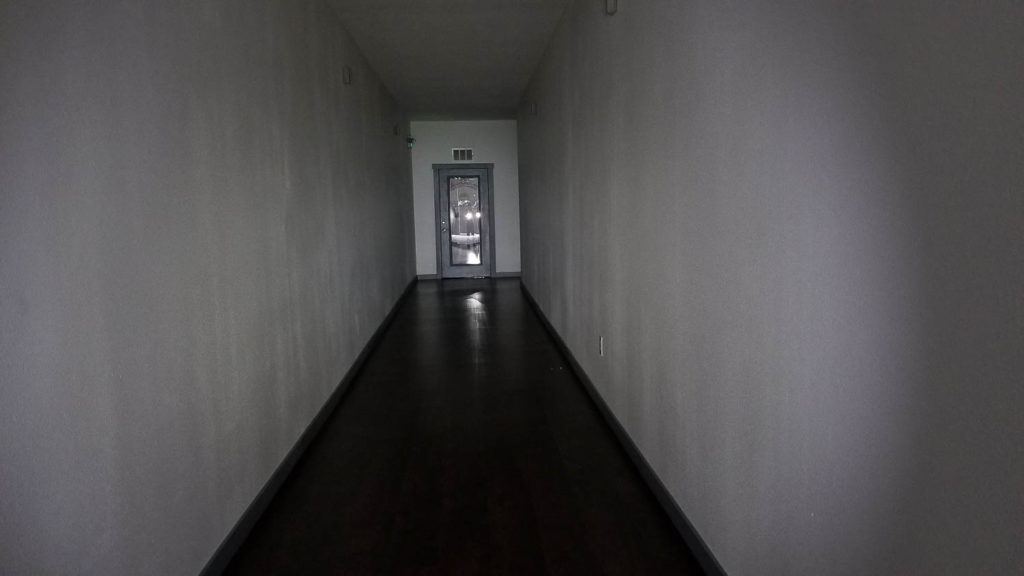
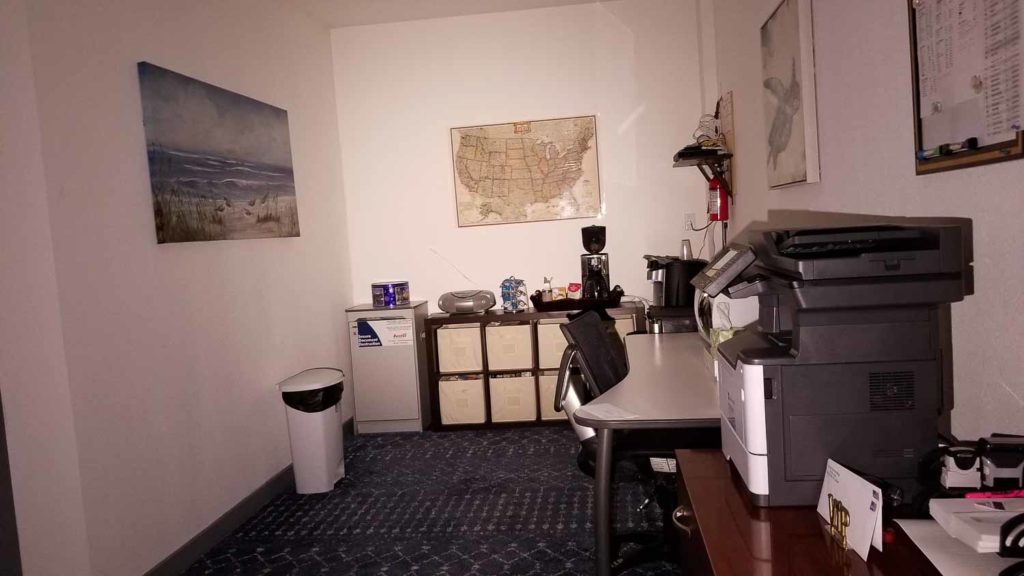
Disclaimer: This flashlight was sent to me for review at no cost by Nealsgadgets. I have not been paid to review, nor have I been holding back on problems or defects.
Final Verdict
Pros
- Great design
- Lightweight and compact
- Excellent build quality and finish
- Excellent warranty
- Incredible performance
- Nice selection of optional LEDs
- Anduril2
Cons
- Anduril2 is complicated
- Switch needs work
- Gets hot fast with quick step downs
- Thermal calibration was off
- Needs more throw
Explanation on star ratings:
1: Avoid: my phone flashlight would be a better choice – 2: Poor: significant defect or issues, much better options available at the same price – 3: Average: some defects or issues – 4: Good: recommended (minor issues) – 5: Great: highly recommended

4.5 stars: ★★★★⋆
By the time I entered this hobby in early 2019, Lumintop had already released the Gigathrower, and had just released the FW3A, and in the next few months released other versions in brass, copper, titanium, and damascus. Around the same time, a single LED (FW1A), and later a fancy version (the LM10), were followed by a quad-LED version (FW4A), and a 21700 powered FW21 with a Pro version sporting 10,000 lumens. That’s quite a lineup!
We can see a continuity model with progression and improvements, which is a very good thing and important for innovation. The FWAA is important for the FW series not because it’s new, but because it takes everything good about the FW format and shrinks it down. Furthermore, it does this without sacrificing much usefulness or practicality. It’s worth noting that if you don’t like 219C’s or SST20’s or XP-G3’s, you can swap in whatever 3535 size LED. Also, did I mention this just looks amazing?
Okay, I really like the FWAA and it will be my go-to EDC light for a while. It’s light, elegant, and smartly designed. The advances in 14500 size batteries have made 2000+ lumens possible, and Anduril2 does a great job managing those lumens (and heat).
This light is a fantastic value to boot. However, it isn’t perfect, and although the switch is beautiful and sized right, the click action is rubbish and I would have liked a little more throw out of it. Although Anduril2 retains the original’s functionality, it has become even more complicated (I didn’t think that was possible, but here we are). With muggle mode missing, even in Simple UI, the full output is available at a newbie’s disposal. Lastly, yah, it gets hot fast, but so do all pocket rockets.
Those shortcomings aside, Lumintop hit it out of the park with the FWAA and I can only see it getting better as time goes on. I am looking forward to improvements down the road, but for now, 4.5 stars for the Lumintop FWAA.
Lumintop FWAA discount code
Use 1lumen711 for 15% off at Nealsgadgets
1lumen selects and reviews products personally. We may earn affiliate commissions through our links, which help support our testing.